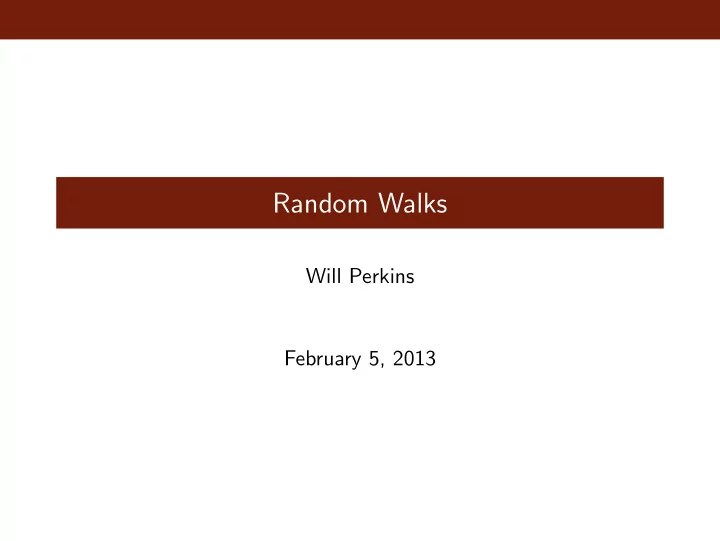

Random Walks Will Perkins February 5, 2013
Simple Random Walk S 0 = 0, S n = X 1 + X 2 + . . . X n , where X i ’s are iid ± 1 with probability p and 1 − p
Combinatorics Calculating the number of simple random walk paths from (0 , 0) to ( n , k ) is finding a binomial coefficient, the only trick is figuring out the number of ‘up steps’. U + D = n U − D = k U = n + k 2
Probabilities To find Pr[ S n = k ] multiply the number of walks by the probability of each walk: � n � n + k 2 (1 − p ) n − n + k Pr[ S n = k ] = p 2 n + k 2
Example Find the asymptotics of Pr[ S n = α n ] for a p -biased SRW. [I.e., find a function g ( n ) so that Pr[ S n = α n ] ∼ g ( n ). ] Exact: � � n (1+ α ) n (1 − α ) n Pr[ S n = α n ] = p (1 − p ) 2 2 (1+ α ) n 2 Asymptotics? Use Stirling’s Formula and Logs When is this probability exponentially small in n ? When is it polynomially small?
Random Walk in Higher Dimension We can define a simple random walk in 2 d , 3 d , or higher. In 2 d the walk starts at (0 , 0) and takes steps on the integer lattice. The set of possible moves are the 4 neighbors of the current location: for (0 , 0) these are (1 , 0), (0 , 1), ( − 1 , 0), and (0 , − 1). Again there is a parity issue: one even steps, the sum of all coordinates is even, and on odd steps, the sum is odd.
Random Walk in Higher Dimension Find the asymptotics of Pr[ S n = (0 , . . . , 0)] for a SSRW in d dimensions.
Random Walk in Higher Dimension d = 2: Idea: project the walk to the two diagonal lines y = x and y = − x , i.e. use a change of basis. In terms of these new coordinates, what happens with one step of the walk?
Random Walk in Higher Dimension What about for d = 3? Can’t just change coordinates. Give an upper and a lower bound on Pr[ S (3) = (0 , 0 , 0)] n
Reflection Principle What is the number of simple random walk paths that go from (0 , 0) to (20 , 10) without going below the x-axis? Draw a picture!
Ballot Theorem In an election, candidate A gets A votes, beating candidate B with B votes. If the votes are counted in a random order, what’s the probability candidate A will always be ahead in the count?
Ballot Theorem Theorem If candidate A receives A votes and B receives B, A > B, then the probability A is always ahead in the counting is A − B A + B Proof by reflection principle
Recommend
More recommend